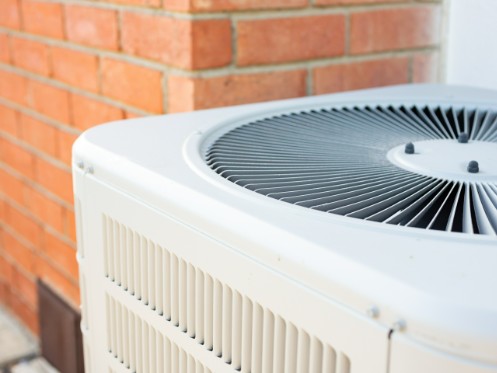Rooftop HVAC systems have surged in popularity since the start of the 21st century. If you have ever looked up at the rooftops of buildings within a city or suburban district, you may have noticed these box-like structures that are responsible for heating and cooling. Rooftop HVAC systems differ from typical central air conditioner systems because they are located above and away from the ground. While rooftop HVAC systems were originally more common among commercial properties, these applications are now popular in residential neighborhoods as well. If you want an alternative to seeing a bulky AC unit in your yard or hearing the constant whir of an HVAC cycle inside your home, you may want to consider a rooftop system instead. An overview of some of the top reasons for placing HVAC systems on the roof can help you determine whether this method is right for you.
What Is a Rooftop HVAC System?
A rooftop HVAC system is a heating, air conditioning, and ventilation system placed on the roof of a building. Traditionally, commercial buildings with flat roofs provided ample space for a rooftop HVAC system’s structure, layout, and setup. More and more often, however, you can also find roof systems among residential dwellings that have flat roofs and space to accommodate a similar framework. This is especially true for hotter regions in which villas, bungalows, or mono-planar roofs are popular. Placing the HVAC system on the roof helps conserve ground space while protecting the units from debris, vandalism, or theft.
How Does a Rooftop HVAC System Work?
A rooftop HVAC system is a type of packaged system that houses all components together in a single cabinet. Due to environmental exposure, this cabinet is made of material designed to withstand sunlight, rain, wind, or other harsh conditions. In the lower portion of the cabinet, air can also travel from ductwork inside the building to keep the temperature of the cabinet’s interior at a stable level.
When an HVAC cycle begins, air first enters the rooftop unit and flows through the system’s filters. The filters within the unit help remove contaminants. The filters ensure that debris does not damage the system’s internal parts and capture many pollutants that would otherwise decrease the air quality in your home. If the system’s configuration and operating mode are for heating, then heat exchanger coils warm up the air. On the other hand, if the configuration and operating mode are for cooling, then evaporator coils cool down the air. Finally, the system’s fan circulates the treated air into ducts, and the building’s ductwork and vents deliver the air to various rooms. The system offers an effective way to heat or cool the interior of a building.
Rooftop HVAC systems differ from split systems or central systems. A split system and many central air systems have a unit indoors and one outdoors. For example, a split system has an indoor air handler that connects to the condenser unit outdoors. In contrast, the rooftop HVAC system consists of a single cabinet that houses both the handler and the condenser.
What Are the Benefits of a Rooftop HVAC System?
There are multiple benefits associated with placing an HVAC system on the roof. Such benefits range from less noise to greater energy efficiency. Some property owners also prefer the “out of sight, out of mind” notion of keeping HVAC units operable but minimally visible. By understanding the benefits, you can determine whether the perks work best for your house and lifestyle.
Space Savings
Placing an HVAC system on the roof frees up the indoor space required to install handlers for split systems. In addition to indoor space, rooftop systems eliminate the need to use up yard space for outdoor condenser units. Whether you need extra space for landscaping or a place for a garden shed, rooftop HVAC systems are a viable way to create space.
Security and Safety
Due to its installation location, a rooftop HVAC system is less vulnerable to vandalism or theft. Unfortunately, HVAC systems installed on the ground level are easier for criminals to access. Thieves interested in stealing copper pipes or wiring are more likely to target ground units. Some thieves even steal entire outdoor units for secondhand resale. Placing your valuable system on the roof can increase your peace of mind. Plus, the method can also increase safety since the unit is less likely to fall victim to damage from lawnmowers throwing rocks or impacts from things like baseballs, bikes, and vehicles.
Acoustics and Operation
Rooftop HVAC systems make much less noise inside your home than conventional split systems. Due to the nature of ground-based systems, you can often hear internal components turn on and off whenever the cycle resets. Placing your HVAC system on the roof provides a degree of noise control in your home.
Ease of Access
HVAC technicians find rooftop systems easier to access and repair. With all components housed together in a single cabinet, replacements and repairs are easier to complete. In addition, technicians can perform important tasks like changing filters or cleaning coils without disrupting the occupants of the home. In the event that your HVAC system needs a significant repair or upgrade, the rooftop location also eliminates the need for tearing down walls, cutting holes in floors, or making the building otherwise inhospitable. And since roof-mounted systems are located on top of the building and do not directly impact the indoor environment, there is no need to worry about dust or debris from repairs entering the building and contaminating the rest of the space. Another benefit is that the rooftop location usually provides plenty of room for upgrades or add-ons.
Improved Ventilation and Airflow
Placing an HVAC system on the roof can also increase airflow to the unit. Weed growth, leaves, or landscaping that needs trimming can often be a problem for units that sit on the ground because they reduce airflow. Placing the HVAC system on the roof can also make it easier for unwanted fumes to vent outside. Since exhaust buildup can increase the chances of problems like carbon monoxide poisoning, it is smart to select a HVAC system placement that helps release these fumes more effectively.
Increased Curb Appeal
Sleek and modern rooftop HVAC units remain tucked away on the roof instead of occupying visible space in the backyard or on the side of a house. While many people view ground-level HVAC units as unsightly eyesores, discreet rooftop units can declutter the space around your home and greatly increase its curb appeal. This improved appearance can make a significant impact on the aesthetics of your home as well as the resale value of the house.
Contact the Experts Today
At Christian Brothers Air Conditioning Plumbing Electrical, we have been serving the residents of Glendale, AZ since 1976. We install, repair, and maintain heating and cooling systems. In addition, we are expert plumbers and electricians. We always deliver quality results and are proud to provide our customers with upfront pricing and honest service.
If you have questions about how a rooftop HVAC system can benefit you, contact Christian Brothers Air Conditioning Plumbing Electrical today.










